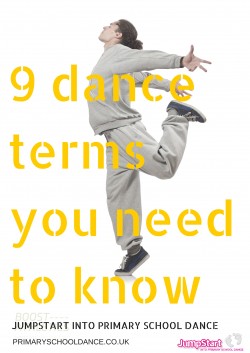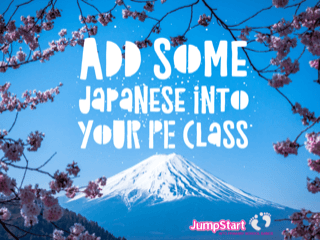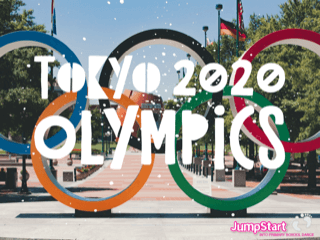Japanese culture has always been a source of mystery and intrigue to western societies and…
9 Dance Terms You Need to Know
 Are you new to teaching dance? Or need to brush up on your dance teaching? JumpStart’s glossary will help you with what you need to know. And if you would like a Dance Artist to come and show you more during a practical training session, email us for more information. This term we’ll be delivering lots of Dance INSET training including schools in Watford, Leeds and Leicester.
Are you new to teaching dance? Or need to brush up on your dance teaching? JumpStart’s glossary will help you with what you need to know. And if you would like a Dance Artist to come and show you more during a practical training session, email us for more information. This term we’ll be delivering lots of Dance INSET training including schools in Watford, Leeds and Leicester.
We are also running our ‘Dance Made Easy’ course which is specifically designed to support Primary School teachers in developing their own skills and confidence in teaching dance. It will run on Friday 16th October – check out the course here.
Here’s our 9 dance terms you need to know…
1.Warm up – an activity that ensures the body is warmed up and ready for the dance class. This should comprise of some elements of…
- Mobility – mobilising the joints and major muscle groups
- Pulse raisers – gently and gradually increasing the range of movements to increase the heart beat
- Stretches – at this age, whole body stretches
The content of the warm up needs to relate to the main part of the dance class, so add in some of the key dance moves you’ll be focusing on, or the atmosphere / theme of the session.
To read more specific information, look back through the previous blog posts. You will also find video examples you can use with your own classes.
2. Movement objectives – the dance focus of the session. You may well be exploring a theme in the dance class (ie. mini-beasts, the jungle, winter) but it is also important to determine specific dance content. I normally select 2 or 3 out of the following categories: shape, body parts, space, time, travel ways/action, dynamics, relationships.
For an example of how I incorporate movement objectives within a lesson plan, become a Jumpstart VIP member here and download the pirate lesson plan for free! (You also receive a video on how to teach street dance).
3. Phrase – two or more movements combined together, often using 8 counts of music. I like to describe a phrase as a movement sentence: the starting position is the capital letter, the 2 (or more) movements are the words and the ending position is the full stop.
You might teach the children a phrase yourself, for example 8 counts of movement that represents creating a magical potion. The children can then learn the phrase and demonstrate it back. Or the phrase might focus on a specific style of dance, such as African Dance.
Or the children can create their own phrases using a starting point / stimulus (see term 5 below for an explanation).
4. Improvisation – creating movement / dance material on the spot, without prior planning. Children are naturally very good at improvising as they have lots of experience of it through their play. Improvisation is a key component of a high quality dance class and can be used to create a dance piece. Once children have improvised, they can select and refine their movement to create a phrase, or a whole dance. Alternatively, improvisation can be the end product in itself – some choreographers use improvisation in their actual performances.
5. Stimulus / starting point – the impetus for creating movement. The starting point for a dancer might be…
- A photo or a piece of art work or an object: for example an image of Antony Gormley’s The Angel of the North.
- A specific music track, a poem, instruments.
- Ribbons, scarves, feathers: how do they make the children want to move?
- Movement that is based around a theme, for example predatory animals, a ‘happy’ emotion dance, outer space exploration.
- Movement in and of itself. For example hopping, falling, a specific style of dance (ie. Street Dance)
6. Dynamics – how movement is performed. Two dancers might be demonstrating the same movement (the same actions, in the same direction) but they might express the movement in completely different ways depending on their movement qualities. Laban categorised dynamics into four components: space, time, weight, flow and for a brilliant explanation of how these are used in dance, visit Dance Advantage here – great article!
7. Choreographic Devices – how a dance performance is structured. Once children have learned or created their own phrases, they can use choreographic devices to develop them into performances. Some of them include…
- Unison. All the dancers perform the same thing at the same time.
- Canon. One / some children perform their phrase, followed by another child / group. This is a bit similar to a Mexican wave – the movement get passed around from person to person. The movement could overlap or not.
- Call and response. A child / group performs some of the actions from the dance, then the rest of the group / another child responds.
- Repetition. Repeating a movement or a phrase again.
8. Cool down – returning the body and mind back to its resting state to avoid blood pooling and fainting. It also re-focuses the children and prepares them to return back to classroom in a calm manner. A cool down may include a slowing down of the dance activity, stretches and relaxation. I really like using Marneta Viegas “Relax Kids” book at the end of my classes as it uses meditation and imagination to calm and relax the children.
9. Contemporary Dance – a style of dance which focuses on experimentation and creativity – exploring what the body can do without the rigors and confines of techniques such as ballet. Significant choreographers influencing the development of Contemporary Dance include Isadora Duncan, Martha Graham, and Merce Cunningham. Today, Contemporary Dance is one of the key styles of dance that professionals use and examples include Matthew Bourne (New Adventures) and Akram Khan (who choreographed for the opening ceremony of the Olympics).
Robert Cohen’s “Waterless Method of Swimming Instruction” is a great example of Contemporary Dance. The piece is fun and easily accessible – the children will love it! See below for a clip from YouTube.
Would you like more in-depth information about any of these topics? I cover a wide-range of issues surrounding dance teaching in my INSET Days. These events include practical training, lesson plans to take away and use, as well as lots of advice and guidance to support you with planning and delivering a dance session. For more information, visit the Dance INSET page or contact me directly [email protected] or call 07738042089.
And JumpStart’s Dance Made Easy course will run on Friday 16th October in Leicester. To book your place visit Eventbrite here.


